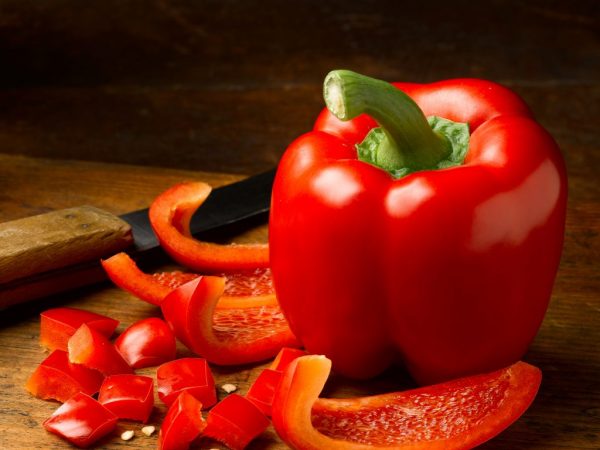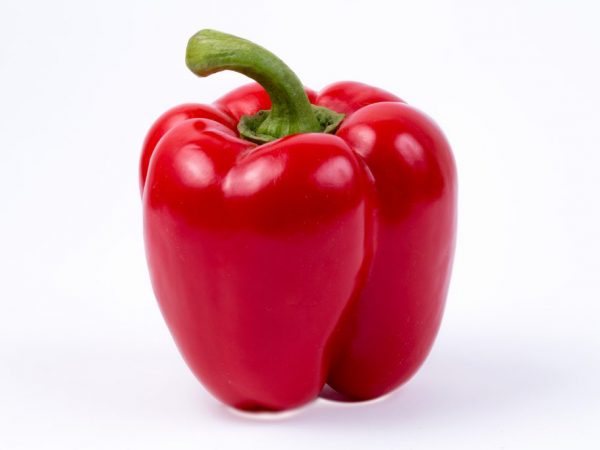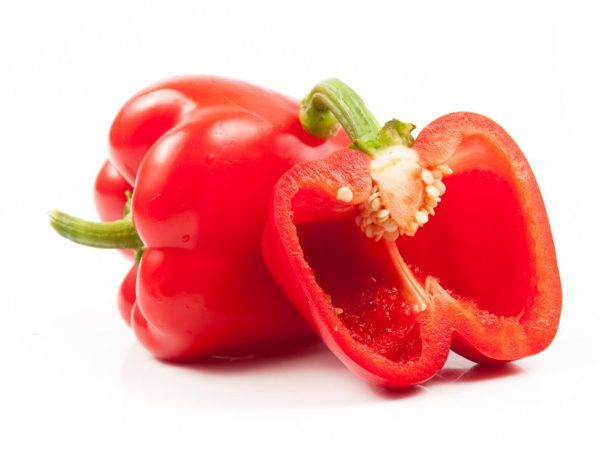Characteristics of Hercules pepper
Hercules pepper is a very popular and high quality hybrid variety. It earned its fame due to its large-fruited, high yield and versatility.

Hercules pepper
With proper agricultural technology, it will delight you with tasty and juicy fruits. Suitable for growing in greenhouses, film tunnels, open field.
Characteristics of the variety
Hercules is an early ripening pepper. From disembarkation of seedlings to the moment of technical ripening, 65-80 days pass. Differs in high and regular productivity. In the greenhouse, more than 3.5 kg of fruit can be harvested, in the open field on average 2-2.5 kg. Which is a high indicator for this culture.
Suitable for industrial cultivation, well transported, not injured. It retains its presentation for two to three weeks during storage, maintaining a temperature of 3-10 ° C, does not fade.
The variety is resistant to small short-term drops in temperature and droughts. It tolerates well the load with a large number of fruits, from this they do not become smaller in size.
Description of the bush
The bush is medium-sized 60-70 cm, with a well-developed central stem and skeletal branches. Compact, which allows 1 sq. M. plant 3 plants. The root system is well developed with a large number of lateral roots, easily supports the weight of the plant and large fruits. Does not require support or garter. The leaves are large, wide, elongated, dark green in color. With a smooth edge and smooth surface.
Description of the fetus
Bell peppers of the Hercules variety have large fruits weighing 200-250 g, some specimens can reach a mass of more than 350 g. They are 10-12 cm long, 8-9 cm wide. 8-12 fruits are formed on one bush. At the moment of technical maturity, the fruits acquire a dark green color, which, upon reaching biological maturation, turns into a deep red. Fruits of a sweet taste with a rich aroma. The composition contains a large amount of sugar 7-8%. Perfect for culinary, fresh consumption and industrial processing. The characteristic difference between the fruits:
- the skin is dense, thin;
- the surface is smooth with a glossy sheen;
- wall thickness 7-10 mm;
- cubic shape, four-chamber;
- the pulp is dense, crispy, juicy, homogeneous in structure;
- seeds are round, flattened, cream color.
Hercules pepper seeds have a high germination rate of 85-95%. But due to the fact that Hercules is a hybrid, the seeds from the grown fruits when sown do not guarantee varietal characteristics such as those of the mother fetus.
Care

Good yield of pepper
Like any other plant, Hercules pepper requires proper care, this will be the key to the development of healthy bushes that will match the description and provide the gardener with high yields.
Watering
Watering peppers of the Hercules f1 variety should be at least once a week, the frequency of watering will also depend on weather conditions. During periods of drought and high temperatures, watering is carried out twice a week, in rainy weather and when the air temperature drops below 20 degrees, watering is reduced or completely canceled.Water the bushes with settled warm water directly under the bush. Watering is best in the morning or evening. For one bush, 2-3 liters of water is enough for one watering.
Water quality can be improved with hydrogen peroxide. One tablespoon of peroxide is added to 10 liters of water. This will bring tap water closer in quality to ozonized rainwater.
Loosening
Loosening saturates the soil with oxygen. This will improve the uptake of nutrients from the soil by the roots. In different periods of the growing season, loosening is carried out at different depths:
- period of active growth before flowering by 5-7 cm;
- during the flowering period until fruiting by 7-10 cm;
- when fruits of 10-12 cm are formed on the bushes;
- after the first removal of the peppers, reduce to 5-7 cm.
Loosening is carried out carefully so as not to damage the roots, the procedure is carried out after watering or rain. Loosening, in addition to improving gas exchange, reduces the germination of weeds.
Top dressing
In order for the peppers to grow, bloom qualitatively, set the fruits, they need to be fed throughout the season. Fertilizers applied correctly and on time will ensure a long fruiting period, and the fruits will grow large and beautifully shaped.
In order to provide plants with adequate nutrition, it is enough to carry out three dressings:
- Nitrogen fertilizers, 14-21 days after transplanting.
- Phosphorus-potassium, during the period of mass flowering.
- Phosphorus-potassium, at the beginning of fruiting.
First feeding
For the first feeding, bird droppings are suitable. A solution is prepared from bird droppings, which will require 0.2-0.3 kg of droppings and 10 liters of water. The ingredients are mixed and left to ferment for 5-7 days. The finished slurry is diluted with clean water in a ratio of 1:10. A groove is made in the aisles and spilled with a solution. Mineral fertilizing with urea will also be able to provide nitrogen. 10 g of fertilizer are dissolved in 10 liters of water. Water the bushes with a solution, avoiding contact with the stems and leaves.
Second feeding
The second feeding can be done with ash, which is rich in phosphorus and potassium, or superphosphate. Peppers respond well to ash make-up. Wood ash can be applied dry or dissolved. A glass of ash is poured with a bucket of water, mixed well, you can add soap as an adhesive (30 g per 10 l). Spray the bushes with the resulting solution.
In the case of using superphosphate, a 0.1% solution is prepared (10 g of fertilizer per 10 l of water), watered or sprayed. 10 sq. M. 10 liters of solution is enough.
Third feeding
The third feeding is carried out with the same fertilizers as the second. But it is preferable to use organic fertilizers (ash) so as not to overload the ripening fruits with chemicals. It must be remembered that all top dressing is best done in the evening on pre-moistened soil.
Bush formation

A good pepper when grown properly
Hercules is a pepper that bushes well without outside help, but there is technology that stimulates additional yields and increases the time of fruiting. To do this, remove the first peduncle at the node of the main stem in the productive part. This stimulates the growth of second-order branches. In the same way, the development of branches of the 3rd and 4th order is provoked. This manipulation allows you to increase the yield by 15-20%.
Diseases and pests
Diseases
Hercules F1 is not a new variety - for many years of cultivation, it has shown itself to be resistant to diseases. The variety is especially resistant to:
- tobacco mosaic;
- pepper spots;
- potato virus.
However, it can be susceptible to late blight. Preventive fungicide treatment can prevent the problem.
A popular prophylactic agent is prepared with garlic. For the medicine, you need 100 g of chopped garlic (stems, cloves, leaves), pour a glass of hot water, leave for 1 day. Dissolve the finished infusion in 10 liters of water, add 1 g of potassium permanganate. Bushes can be sprayed with such a solution every 14 days at any stage of the growing season.Biological products such as Trichodermin or Fitosporin are safe to use. Prepare the solution in accordance with the manufacturer's instructions and spray the bushes.
Pests
During periods of high temperatures and drought, Hercules f1 pepper can be affected by aphids, spider mites, whiteflies. Such simple means as laundry soap or ammonia will help to cope with the pest.
- To treat the bushes, laundry soap (100g) is grated and poured with 10 liters of warm water, kneaded until completely dissolved and sprayed on the bushes. The treatment is carried out in the morning, and the next day it is washed off with water. Treatments are carried out several times at intervals of 7-10 days until the disappearance of the pests.
- To 10 water add 20 g of ammonia and 30 g of liquid soap and spray the bushes. Sprayed in the evening or morning. This solution scares away pests, and at the same time serves as a top dressing.
If folk recipes could not solve the problem, then the bushes are treated with insecticides (Aktara, Bioreid, Aktelik), keeping the dosage and method of application specified by the manufacturer.
Conclusion
Pepper Hercules f1 is a quality hybrid that will delight you with a high yield, beautiful large fruits. Stable fruiting, taste characteristics and simple agricultural techniques are the advantages that persuade summer residents and farmers to choose this variety for cultivation.


